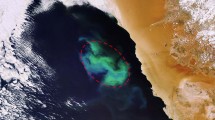Abstract
As ocean biogeochemical models evolve to permit the elemental composition of plankton populations and dissolved organic matter to vary, each element is normally assigned a separate state variable, which is advected and mixed independently of the others. In a population of cells with varying elemental quotas, the proper currency of the advection operator is subpopulations of similar cells. The spatial gradient in total C, N, or P summed over the spectrum of such subpopulations is identical to that calculated for the population means, so treating the various elements as independent should generally be a valid approximation. However, errors can arise in high-order advection schemes with nonlinear corrector terms, which are not additive across the subpopulations. Some numerical examples indicate that these errors are relatively small [O(10−3–10−4)] but can be as high as O(10−2) in certain cases. As grid resolution varies, the error scales approximately to the Courant number.





Similar content being viewed by others
References
Abraham ES, Law CS, Boyd PW, Lavender SJ, Maldonado MT, Bowie AR (2000) Importance of stirring in the development of an iron-fertilized phytoplankton bloom. Nature 407:727–730
Anderson TR, Williams PJL (1998) Modelling the seasonal cycle of dissolved organic carbon at Station E1 in the English Channel. Est Coast Shelf Sci 46:93–109
Bidigare RR, Ondrusek ME (1996) Spatial and temporal variability of phytoplankton pigment distributions in the central equatorial Pacific Ocean. Deep-Sea Res II 43:809–833
Bissett WP, Walsh JJ, Dieterle DA, Carder KL (1999) Carbon cycling in the upper waters of the Sargasso Sea: I. Numerical simulation of differential carbon and nitrogen fluxes. Deep-Sea Res 46:205–269
Bissett WP, Arnone R, DeBra S, Dieterle DA, Dye D, Kirkpatrick GJ, Schofield OM, Vargo GA (2005) Predicting the optical properties of the West Florida Shelf: resolving the potential impacts of a terrestrial boundary condition on the distribution of colored dissolved and particulate matter. Mar Chem 95:199–233
Boris JP, Book DL (1973) Flux-corrected transport. I. SHASTA, a fluid transport algorithm that works. J Comp Phys 11:38–69
Christian JR (2005) Biogeochemical cycling in the oligotrophic ocean: Redfield and non-Redfield models. Limnol Oceanogr 50:646–657
Christian JR, Verschell MA, Murtugudde R, Busalacchi AJ, McClain CR (2002) Biogeochemical modelling of the tropical Pacific Ocean. I. Seasonal and interannual variability. Deep-Sea Res II 49:509–543
Geider RJ, MacIntyre HL, Kana TM (1998) A dynamic regulatory model of phytoplanktonic acclimation to light, nutrients, and temperature. Limnol Oceanogr 43:679–694
Levy M, Estublier A, Madec G (2001) Choice of an advection scheme for biogeochemical models. Geophys Res Lett 28:3725–3728
Lin S-J, Chao WC, Sud YC, Walker GK (1994) A class of the van Leer-type transport schemes and its application to the moisture transport in a general circulation model. Mon Weather Rev 122:1575–1593
Moore JK, Doney SC, Kleypas JA, Glover DM, Fung IY (2002) An intermediate complexity marine ecosystem model for the global domain. Deep-Sea Res II 49:403–462
Moore JK, Doney SC, Lindsay K (2004) Upper ocean ecosystem dynamics and iron cycling in a global three-dimensional model. Global Biogeochem Cycles 18: DOI 10.1029/2004GB002220
Oschlies A (2000) Equatorial nutrient-trapping in biogeochemical ocean models: the role of advection numerics. Global Biogeochem Cycles 14:655–667
Press WH, Teukolsky SA, Vetterling WT, Flannery BP (1992) Numerical recipes in FORTRAN. Cambridge University Press
Redfield AC, Ketchum BH, Richards FA (1963) The influence of organisms on the composition of sea-water. In: Hill MN (ed) The Sea. Wiley, pp 26–77
Rood RB (1987) Numerical advection algorithms and their role in atmospheric transport and chemistry models. Rev Geophys 25:71–100
Sterner RW, Elser JJ (2002) Ecological stoichiometry: the biology of elements from molecules to the biosphere. Princeton University Press
van Leer B (1977) Towards the ultimate conservative difference scheme. IV. A new approach to numerical convection. J Comp Phys 23:276–299
Zalesak ST (1979) Fully multidimensional flux-corrected transport algorithms for fluids. J Comp Phys 31:335–362
Acknowledgment
This research was supported in part by the NSF Biological Oceanography program. I am very grateful to Patrick Cummins, Bill Merryfield, Adam Monahan, and John Scinocca for useful and provocative discussions about the issues discussed in this paper. Bill Merryfield, Ken Denman, and three anonymous reviewers made useful comments on earlier drafts of this paper. The codes used for the FCT and Lin advection schemes were modified from versions written by Patrick Cummins.
Author information
Authors and Affiliations
Corresponding author
Additional information
Responsible editor: Andreas Oschlies
Rights and permissions
About this article
Cite this article
Christian, J.R. Advection in plankton models with variable elemental ratios. Ocean Dynamics 57, 63–71 (2007). https://doi.org/10.1007/s10236-006-0097-7
Received:
Accepted:
Published:
Issue Date:
DOI: https://doi.org/10.1007/s10236-006-0097-7




